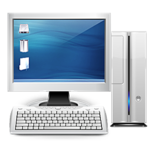Computer Basics/Ergonomics/Computer equipment
From WikiEducator
| Computer Basics | |
|---|---|
| Ergonomics | Introduction | Furniture | Computer equipment | Exercises | Environmental factors | Key points | Assessment |
Monitors
If you work with a monitor, tired, sore or blood-shot eyes indicate eye strain. The following points indicate some aspects of monitors to be aware of.
- Position: Place the monitor a comfortable distance away from the eyes (20-40 inches or 50-100 cm). Have it in a position where you can look into the distance at regular intervals - to the side of a window is an ideal position. You need to change the focus of your eyes on a regular basis to prevent eye strain.
- Angle: The monitor should be slightly below eye level. Looking up at a monitor can cause strain in the neck.
- Anti-glare screen: Reflections on the screen can cause eye strain and headaches. This can be overcome by using a monitor filter with an anti-glare screen or by placing a special anti-glare cover in front of the screen.
- Focus: The image on the screen should be sharp. Poor quality monitors have a slightly blurred effect. This causes the eyes to continually attempt to reduce the blur.
- Set the contrast and brightness of the monitor to avoid eye strain.
- Low radiation: The beam of electrons that strikes the screen to display the image also sends out electromagnetic radiation. Use a monitor with low electromagnetic radiation.
- Refresh rate: The refresh rate of a monitor is the rate at which it updates the images on the screen. When the refresh rate is too low, the screen appears to flicker. Apart from the annoyance factor, this causes eye strain. The refresh rate should be at least 72 Hz (72 times a second) and preferably higher.
- Rest: Take regular rest periods where you do not look at the monitor.
Keyboards and mouse
Repeated use of the same muscles and joints can result in a type of injury called RSI or Repetitive Strain Injury. This type of injury can range from inflammation of joints, to damaged ligaments and muscles or even hairline fractures in bones. RSI is usually caused by the incorrect use of the keyboard and mouse.
- When using a keyboard your wrists should be straight and relaxed to avoid strain. Placing a padded wrist rest in front of your keyboard can provide extra support for wrists.
- Ergonomic keyboards: Ergonomic keyboards are designed in such a way that the strain on the hands and finger are reduced.
- Touch typing: Learning to touch type can help reduce strain as it distributes the work evenly between the fingers. Users who can touch type also tend to use far less force when striking the keyboard.
- Locate the mouse close to the keyboard to avoid discomfort in using it.
- Mouse mats (pads): Mouse mats or pads are available with a cushion for the wrist to rest on. Repeated clicking of the mouse buttons can lead to inflamed finger joints. Resting the wrist on the cushion reduces this effect.
- Rest: Take regular breaks to rest the muscles and joints.

